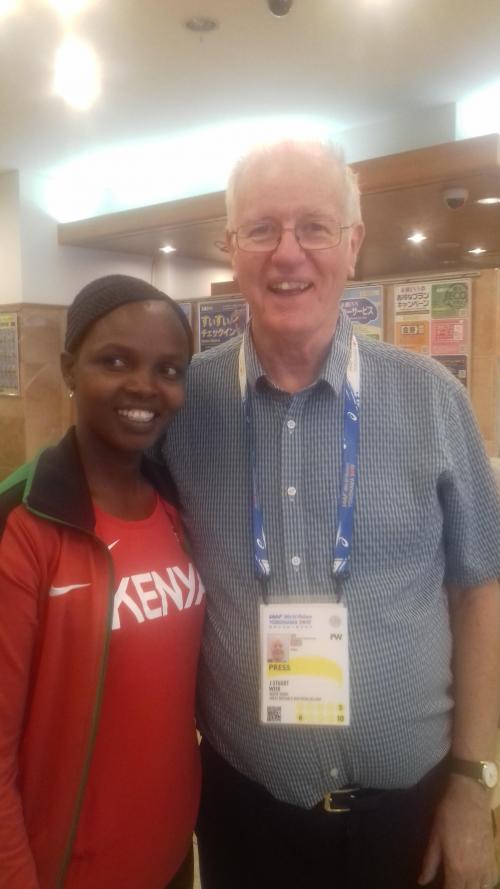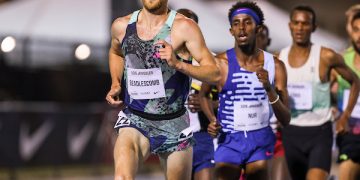The women’s steeplechase was a fast one in Oslo. For the first time, fifteen women went under nine minutes and 35 seconds. Thanks to Jon Mulkeen, one of our sport’s most prominent statisticians, for that.
Stuart Weir wrote this piece, his third, on Oslo on the steeplechase and its former meet record holder.
RelatedPosts
Fantastic sprint from Jeruto off the final hurdle to take the win in a WL 9:03.71.#OsloDL 🇳🇴 #DiamondLeague pic.twitter.com/EDC609vyp2
— IAAF Diamond League (@Diamond_League) June 13, 2019
Women’s steeplechase
There are some moments when the wonderful officials without which our sport could not exist, show that they are human. There was Jess Ennis’ world record in the Manchester City Games in the 100m hurdles with only 9 hurdles! Last year’s Bislett Games Steeplechase is in the same category. I’ll let Emma Coburn take up the story of the 2018 race.
“Last year one of the barriers was set at the men’s height (36 inches) and not women’s height (30 inches) – that is a big difference. When I went over it the first time I yelled at my husband (also my coach), who was in the stands to let him know it was the wrong height. Second lap it was still at wrong height. When we came round the third time my husband Joe and an official were on the track, trying to get it to the correct height.
“It was a bit of a disaster and some people fell because it was so high. While I did not fall, it definitely rattled my focus a bit. And for the rest of the race I was feeling a bit frustrated and not fully engaged with my goals for the race. I was second and nearly won but yes it was a little bit of a frustrating race”.
9:08 and 4th place. Solid start to the year. https://t.co/BeTe2KR2pl#OsloDL#DiamondLeague#RoadToTheFinal pic.twitter.com/4Q2hf1L0Nx
— emma coburn (@emmajcoburn) June 14, 2019
The good news is that the barriers were all correctly set for the 2019 race. So, when I spoke to Emma before the race, what – apart from hurdles at the right height – was she hoping for: She replied: “This year I really don’t know what to expect. With my focus on Doha, I have been delaying my race preparation. I am pretty rusty with the steeplechase and have not really done it in practice. I know I am pretty fit so hopefully I can go out and run fast but I don’t really know what to expect from the race as normally I would have had more race practice”.
World record holder, Beatrice Chepkoech, looked to have the race under control but on the final straight Norah Jeruto overtook her to win in 9:03.71 and by half a second from Chepkoech. Hyvin Kiyeng was third and Emma Coburn fourth. Coburn ran much of the race on Kiyeng’s shoulder and then overtook the Kenyan with a couple of laps to go only for Kiyeng to regain the lead in their personal battle.
Jeruto’s time was a meeting record and a world lead. The race also yielded six PRs and two national records. And something that few other that IAAF’s Statsman John noticed. 15 women finishing inside 9:35 and that has never happened before.
Perhaps something was lost in translation but the winner’s comments were a bit understated: “It was not bad”, she said. Glad to know that a world lead and meeting record are not bad! She did add: “I tried my best, I felt comfortable and confident. The crowd was very good, I enjoyed it. I was very pleased with my time and it was good to beat those girls”.
As a final note on the race, I like to look at Meeting records because they recall good performances from the past. The meeting record holder before Jeruto was Milcah Chemos from 2012. Chemos has been in my thoughts this year. I remember being in Moscow in 2013 when she won the world title. I was delighted to see her again at the World Relays in Yokohama where she was part of the Kenyan team management
 Milcah Chemos and Stuart Weir, photo by Stuart Weir
Milcah Chemos and Stuart Weir, photo by Stuart Weir
Author

Since 2015, Stuart Weir has written for RunBlogRun. He attends about 20 events a year including all most global championships and Diamond Leagues. He enjoys finding the quirky and obscure story.
View all posts




















